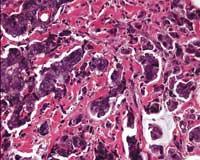Breast cancer in young women
2003/11/01 Andonegi Beristain, Garazi - Elhuyar Zientziaren Komunikazioa Iturria: Elhuyar aldizkaria
Breast cancer is the most common type of cancer suffered by women in industrialized countries, and is also the second most deadly disease.
When this disease appears in young women, experts believe that there are some genetic background that, in most cases, are associated with tumor suppressor gene errors. Elimination genes are genes that prevent the expression of another gene. These genes may be mutated, not expressed, have some failure in the start-up system (methylation) or missing the gene or part of it (loss) to not work well.
Although initially thought so, in young women with breast cancer, mutations of known eliminator genes (Brca1, Brca2, ATM, Che2...) appear less than expected and are often difficult to detect. Therefore, it is intended to find new treatment markers in clinics to know the development of breast cancer. According to these markers, for example, you want to decide who needs chemotherapy and who does not.
Double problem

Analyzing the loss of genes eliminators, it seeks to find markers in Leioa that indicate whether breast cancer will be more aggressive or weaker.
Each woman has two copies of each elimination gene, one on each chromosome. Only when these two copies are damaged the disease develops, so young women consider that in women with breast cancer they have one of these birth defects. The second error would occur in the chest itself, in maturity. In addition, according to research and considering the probability, one of the two errors necessary for the development of the disease can be the loss of part of the DNA.
Given this hypothesis, several hospital and university groups try to determine the importance of the loss of DNA fragments in certain areas of the genome in the development of the disease, that is, in prognosis.
Significant losses
A Leioa research group is working on it. These studies use healthy cells, tumor cells, and around the tumor through microdissection. They then compare tumor cells to healthy cells and check for loss or not. So, they want to know if the cancer will be weaker or more aggressive based on this loss.
This study was carried out in DNA fragments that until now were known cancer-removing genes. Now other regions of DNA are also being studied and if some part of them is missing, one might think that there is a gene that is not known because the disease is already there.
This study is part of a major breast cancer research project in which the Hospital de Basurto and the Faculty of Pharmacy of Vitoria-Gasteiz also participate. Basurto Hospital studies mutations of breast cancer killer genes and their methylation in Vitoria. This aims to analyze all aspects of breast cancer in young women and to make a more accurate prognosis of the disease so that patients receive the most appropriate treatment.
- Title of the project
Value of allelic instability and loss of heterogeneity in the prognosis of premature breast cancer and familial breast cancer. - Objective Research of the prognostic
value of mutations found in the BRCA1, BRCA2, and Analysis of the value of allelic losses in women with familial breast cancer or early sporadic cancer. - Director Africa García
Orad. - • Txagorritxu
Hospital: Department of Pathological Anatomy UPV Medicine (Leioa): Department of Genetics, Physical Anthropology and Physiology - • Faculty
of Medicine (Leioa)

Gai honi buruzko eduki gehiago
Elhuyarrek garatutako teknologia





